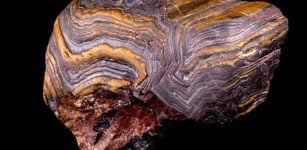Climate Change’s Impact On Earth’s Rotation
Eddie Gonzales Jr. – MessageToEagle.com – Researchers at ETH Zurich have used AI to model long-term polar motion causes.
Their findings indicate that climate change and global warming will impact Earth’s rotational speed more significantly than the moon’s effect, which has historically governed day length increases.
Polar motion observations. Credit: Nature Geoscience (2024). DOI: 10.1038/s41561-024-01478-2
Climate change is melting ice in Greenland and Antarctica. This meltwater is flowing into oceans, particularly near the equator.
Benedikt Soja, Professor of Space Geodesy at ETH Zurich said that ” a shift in mass is affecting Earth’s rotation.”
Soja compares it to a figure skater’s pirouette: spinning fast with arms close, then slowing as arms extend. This increase in distance from the rotation axis raises physical inertia.
The law of conservation of angular momentum governs Earth’s rotation. Climate change affects Earth’s rotation speed, minimally altering the length of days.
The ETH Zurich study in PNAS reveals that climate change is lengthening days by milliseconds. This occurs as water flows from poles to lower latitudes, slowing Earth’s rotation.
Tidal friction caused by the moon also slows Earth’s rotation. However, a new study suggests that increasing greenhouse gas emissions and resulting global warming could impact Earth’s rotational speed more significantly than the moon’s long-standing influence.
“We humans have a greater impact on our planet than we realize, and this naturally places great responsibility on us for the future of our planet,” the researcher said in a press release.
Melting ice causes shifts in Earth’s mass, affecting its rotational speed, day length, and axis of rotation. This alters the Earth’s polar motion, observable as a ten-meter shift over a century. Both ice sheet melting and internal Earth movements contribute to this phenomenon.
Deep in Earth’s mantle, high pressure makes rock viscous, causing slow displacements. Heat flows in the outer core’s liquid metal generate Earth’s magnetic field and cause mass shifts.
“We’ve discovered the full explanation for long-period polar motion,” says lead author Mostafa Kiani Shahvandi. “We now understand why and how the Earth’s rotational axis moves relative to its crust.”
“Ongoing climate change could therefore even be affecting processes deep inside the Earth and have a greater reach than previously assumed.” However, there is little cause for concern, as these effects are minor and it’s unlikely that they pose a risk,” Kiani Shahvandi adds.
Papers:
Kiani Shahvandi, Mostafa, The increasingly dominant role of climate change on length of day variations, Proceedings of the National Academy of Sciences (2024). DOI: 10.1073/pnas.2406930121. doi.org/10.1073/pnas.2406930121
Mostafa Kiani Shahvandi et al, Contributions of core, mantle and climatological processes to Earth’s polar motion, Nature Geoscience (2024). DOI: 10.1038/s41561-024-01478-2. www.nature.com/articles/s41561-024-01478-2
Written by Eddie Gonzales Jr. – MessageToEagle.com Staff Writer











